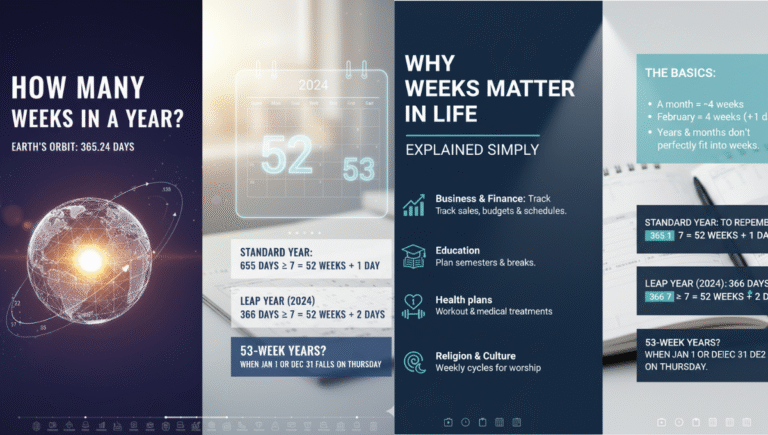Time is something we all use every day, yet its structure often goes unnoticed. We know a year has 12 months, 365 days (or 366 in a leap year), but what about weeks? Many people ask the simple question: how many weeks are there in a year? The answer may seem straightforward at first, but once we break it down, we find that the math has a few interesting details.
The Basic Calculation
To figure out the number of weeks in a year, we start with the basics:
-
A standard year has 365 days.
-
One week has 7 days.
So, dividing 365 by 7 gives:
-
Dividing 365 days by 7 gives 52 full weeks with one day left over.
So, a normal year contains 52 complete weeks and one leftover day.
What About a Leap Year?
Every four years, the calendar includes an extra day in February, making it a leap year with 366 days. This happens to keep our calendar in line with Earth’s orbit around the sun.
If we divide 366 by 7, we get:
-
In mathematical terms, 366 ÷ 7 results in 52 weeks and two remaining days.
So, during a leap year, there are still 52 full weeks, but this time with 2 extra days instead of one.
Why Don’t Years Fit Perfectly into Weeks?
It might seem strange that a year doesn’t divide evenly into weeks. After all, our calendars are carefully planned. The reason is that the calendar year is based on the time it takes Earth to orbit the sun—about 365.24 days. Since a week is a human-made time measurement of 7 days, the two systems don’t align perfectly.
As a result, no year has exactly 53 full weeks. Instead, we always get 52 weeks and a leftover day (or two in leap years).
When Can a Year Have 53 Weeks?
Although a year normally has 52 weeks, sometimes a calendar year is said to have 53 weeks. This happens when January 1st or December 31st falls on a Thursday (in some cases, a Wednesday or Friday, depending on the calendar system used).
Here’s why:
-
52 weeks equal 364 days.
-
Since most years have 365 or 366 days, that extra day (or two) can create an additional “week number” in the yearly calendar.
For example:
-
When January 1 falls on a Thursday in a regular year, December 31 will also land on a Thursday. That means you’ll see week 53 in calendars that count weeks.
-
The same applies if a leap year starts on a Thursday or ends on a Thursday—adding an extra week in the numbering system.
So, while technically it’s still 52 weeks plus extra days, the way weeks are labeled can make some years appear to have 53.
Why Weeks Matter in Everyday Life
You might wonder why knowing the number of weeks in a year is important. For many people, weeks are more practical than days or months when planning schedules.
-
Business and finance: Companies often work with “fiscal weeks” to track sales, budgets, and employee schedules.
-
Education: School years are typically planned in terms of weeks rather than days, making it easier to set semesters and breaks.
-
Health and fitness: Workout plans, pregnancies, and medical treatments are often measured in weeks.
-
Religion and culture: Many traditions follow a weekly cycle, with specific days for rest or worship.
Understanding weeks helps organize life in manageable chunks, which is why the question “how many weeks are in a year?” is more useful than it may appear.
The Connection Between Weeks, Months, and Years
Here’s another way to look at it:
-
A month usually has 30 or 31 days, which equals about 4 weeks and 2 or 3 days.
-
February typically has 28 days, or 29 in a leap year, which amounts to four complete weeks plus one extra day.
This is why months don’t perfectly fit into weeks, just like years don’t. It’s all a matter of dividing days into cycles that are convenient for human use.
A Simple Way to Remember
If you’re ever unsure, here’s the easiest way to keep it in mind:
-
A regular year = 52 weeks + 1 day
-
A leap year consists of 52 full weeks plus two extra days.
-
And occasionally, depending on how the calendar falls, a year can appear to have 53 numbered weeks.
Final Thoughts
So, how many weeks make up a year? The simple answer is 52 weeks, with a little extra. That “extra” day or two is what keeps our calendars aligned with Earth’s orbit around the sun.
While it may seem like a small detail, understanding the relationship between days, weeks, and years helps us see how time is structured—and why our calendars look the way they do. From work schedules to school terms, weeks are the building blocks of our daily lives. And though a year may never fit perfectly into weeks, those 52 cycles of seven days remain one of the most practical ways we measure time.
